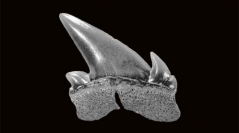

 Comptes Rendus Palevol
4 (1-2) - Pages 95-107
Comptes Rendus Palevol
4 (1-2) - Pages 95-107The Cretaceous period represents crucial times in vertebrate evolution, notably with the emergence of modern mammal groups. In Europe, continental formations are restricted to the basal and Latest Cretaceous (Wealdian and Campano-Maastrichtian). Concerning the middle part of the Cretaceous, continental vertebrate faunas are poorly known, generally through some particular assemblages deposited in paralic environments and mostly composed of microremains. Such a deposit, recently found in the Early Cenomanian of Fouras (Fouras-Vauban locality, Charente-Maritime, southwestern France), has yielded a rich association, improving our knowledge. Beside abundant coastal fish remains, tetrapods are represented by chelonians, crocodilians, ophidians, plesiosaurs, pterosaurs, and dinosaurs. The occurrence at Fouras-Vauban of certain typical Gondwanan forms (the freshwater shark Tribodus and a zyphodont crocodilian close to Hamadasuchus) allows us to discuss about the palaeobiogeographical affinities of faunas living in the European archipelago during the Mid-Cretaceous and the trans-Tethyan ways of communication between Western Europe and North Africa.
Vertebrates, Selachians, crocodilians, dinosaurs, palaeobiogeography, Cenomanian, Southwestern France